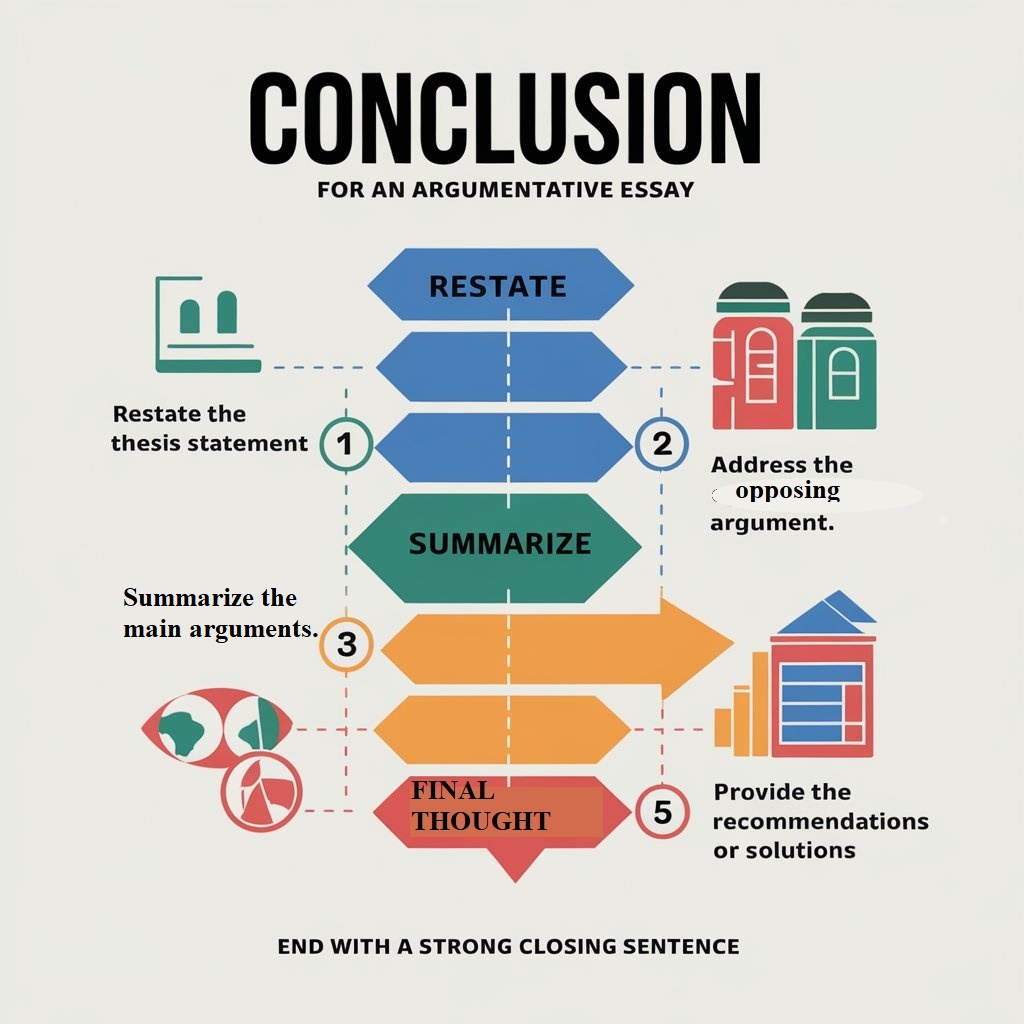If you are writing a conclusion for an argumentative essay. You should not overlook this crucial element. A weak or abrupt ending can leave readers unconvinced, while a well-written conclusion reinforces your stance and leaves a lasting impact.
We will explore the key strategies for writing an effective conclusion. This will help you, as a student, conclude your essays confidently and clearly.
Components of a Strong Conclusion Paragraph
A firm conclusion for an argumentative essay is the final opportunity to reinforce your argument, persuade the reader, and provide a sense of closure. Let us check the key components of an effective conclusion,
1. Restate the Thesis (Paraphrased Thesis Statement)
The conclusion should begin by rewording the thesis rather than simply repeating it. This reinforces the central claim of the essay while demonstrating your ability to reframe the argument effectively.
Example: “Extensive research confirms that social media negatively affects mental health by promoting anxiety, depression, and addictive behaviors, ultimately harming users’ well-being.”
2. Summarize Key Arguments
Briefly summarize the most critical points made in the body paragraphs. This reinforces the essay’s main arguments without introducing new information.
Example: “As demonstrated, social media fosters unrealistic comparisons, disrupts real-life interactions, and manipulates users into seeking validation through digital engagement. These patterns contribute to a significant rise in depression and social anxiety among young adults.”
3. Address and Refute Counterarguments (If Applicable)
If your essay includes counterarguments, the conclusion can reaffirm why your main argument remains strong despite opposing viewpoints.
Example: “While some argue that social media enhances global connectivity, its detrimental effects on mental well-being outweigh its benefits. Platforms that prioritize profit over users’ psychological health demand urgent scrutiny and reform.”
4. Discuss the Broader Implications
A firm conclusion extends beyond a mere summary to discuss why the argument matters in a larger context. This could include ethical considerations, long-term consequences, or societal impact.
Example: “If left unchecked, the mental health crisis linked to excessive social media use will continue to escalate, affecting future generations. Addressing this issue now is crucial to fostering a society that prioritizes well-being over digital validation.”
5. End with a Strong, Memorable Closing Statement
A powerful final statement leaves a lasting impression. This could be a call to action, a rhetorical question, or a thought-provoking insight.
Example: “As we navigate an increasingly digital world, the real question is not whether social media affects mental health, it does but whether we will take meaningful steps to mitigate its harm before it’s too late.”
Read also on 10 mistake to avoid when writing an argumentative essay
Argumentative Essay Conclusion Outline
A well-structured Conclusion for an argumentative essay should reaffirm your thesis, summarize key points, address counterarguments, and leave a lasting impact on the reader. This is a practical outline:
1. Restate the Thesis in a New Way
- Reword the thesis to reflect the argument’s progression.
- Emphasize how the essay successfully defended your stance.
2. Summarize Key Supporting Arguments
- Briefly synthesize (not just list) the main points.
- Show how they interconnect to support your thesis.
3. Address and Refute Counterarguments (If Applicable)
- Acknowledge opposing viewpoints in one or two sentences.
- Show why they are less convincing than your argument.
4. Discuss the Broader Implications
- Explain why this argument matters beyond the essay.
- Consider ethical, social, or long-term consequences.
5. End with a Strong, Memorable Closing Statement
- Challenge the reader to think critically or take action.
- Use a rhetorical question, a call to action, or a powerful final thought.

How to Start a Strong Conclusion for an Argumentative Essay
A firm conclusion should reinforce your main argument, provide a sense of closure, and leave a lasting impression on the reader. Check on how to write an impactful conclusion:
1. Restate the Thesis in a Fresh Way
Avoid repeating your thesis word-for-word. Instead, rephrase it to reinforce your stance while showing a deeper understanding of the topic.
Example:
- Original Thesis: “Online education provides more flexibility and accessibility than traditional classrooms.”
- Restated Thesis: “With its ability to provide flexible schedules and broaden access to education, online learning has transformed the way students acquire knowledge.”
2. Summarize the Main Points
Briefly recap your most potent arguments to remind the reader why your position is valid. Keep this summary concise and focus on the key takeaways.
Example:
“Throughout this discussion, we have explored how online education offers cost-effective learning opportunities, allows students to study at their own pace, and provides access to a wider range of courses.”
3. Use a Transition Phrase to Introduce Your Final Thought
Transition smoothly into your closing statement by using phrases like:
- “In conclusion, it is evident that…”
- “Ultimately, the evidence suggests that…”
- “Therefore, embracing this change can…”
- “With these points in mind, it becomes clear that…”
4. Provide a Thought-Provoking Closing Statement
End with a final thought that leaves a strong impression on the reader. This could be a call to action, a thought-provoking question, or a broader implication of your argument.
Example:
- “As technology continues to evolve, online education will likely become the standard, making knowledge more accessible to people worldwide.”
- “Given these advantages, educational institutions should continue expanding digital learning opportunities to ensure a more inclusive academic environment.”
- “If we embrace online education, we can pave the way for a future where learning is no longer limited by time, location, or financial constraints.”
Common Mistakes to Avoid in an Argumentative Essay Conclusion
- Introducing New Information – The conclusion should reinforce, not expand, the discussion. New arguments or evidence belong in the body paragraphs. Avoid this completely.
- Restating the Thesis Without Adding Value – Avoid repeating the thesis verbatim. Instead, rephrase it to reinforce its significance. When you copy and paste the thesis from the introduction to the conclusion, it will lack meaning.
- Being Too Vague or Weak – Avoid uncertain language like “I think” or “maybe.” Be confident in your stance. Always avoid the words that express you as not confident your professor will deduct marks for that.
- Failing to Address the Counterargument – If counterarguments were discussed, briefly reinforce why your argument is more substantial.
- Ending Abruptly – Ensure a smooth transition to the final thought to avoid making your essay incomplete.
- Overusing Clichés – Phrases like “In conclusion” or “All in all” can feel redundant. Use a natural transition instead.
- Ignoring the Bigger Picture – Highlight the broader significance of your argument. Why does it matter? How does it relate to real-world issues?
Tips for Writing a Strong Conclusion for an Argumentative Essay
- Consider Your Audience – Consider who will read your essay and what will resonate with them. Look at the rubric if you are writing it for a professor and want a good grade.
- Keep it Concise – Aim for 5-7 impactful sentences summarising and reinforcing your argument. Avoid making it too long. The conclusion may lose meaning.
- Edit and Revise – Ensure clarity, grammatical accuracy, and coherence. Use tools like Grammarly. You can revise your conclusion several times until it is strong.
- Refer to Credible Sources – Supporting your argument with authoritative references enhances credibility. Consult academic resources such as:
How to Format the Conclusion for an Argumentative Essay
- Start with a New Paragraph –The conclusion should always begin on a separate line. Make sure it has started in a new paragraph.
- Maintain Proper Indentation & Spacing—Follow academic formatting (e.g., double-spacing, standard margins, and indentation) to make the essay presentable.
- Use a Clear, Concise Font – Stick to academic standards (e.g., Times New Roman, 12pt, double-spaced).
- Avoid Subheadings or New Information – Keep the focus on reinforcing your main argument.
- Keep it Brief but Effective – Aim for 5-7 sentences that restate the thesis, summarize key points, and offer a final thought.
Final Thoughts
A firm conclusion solidifies your argument, persuades the reader, and leaves a lasting impression. By following these strategies and avoiding common mistakes, you can write a conclusion that enhances the effectiveness of your argumentative essay.
Would you like to refine your writing further, or do you need additional resources? Check out academic writing guides from reputable institutions to elevate your essay-writing skills. If you need assistance writing a good argumentative essay, contact us.









 Evan John
Evan John